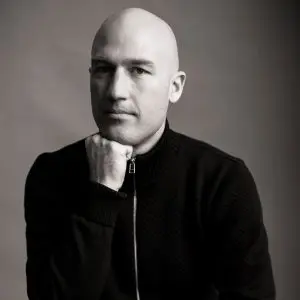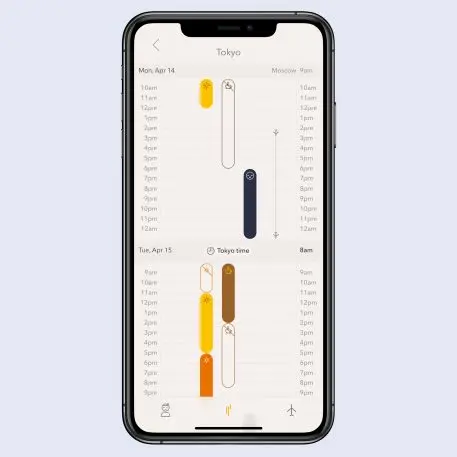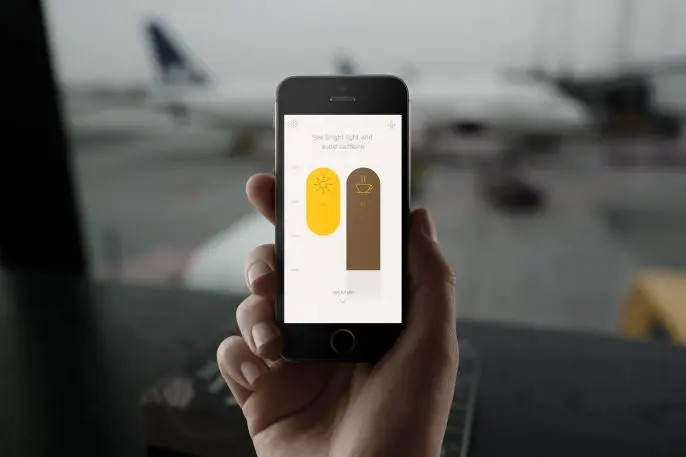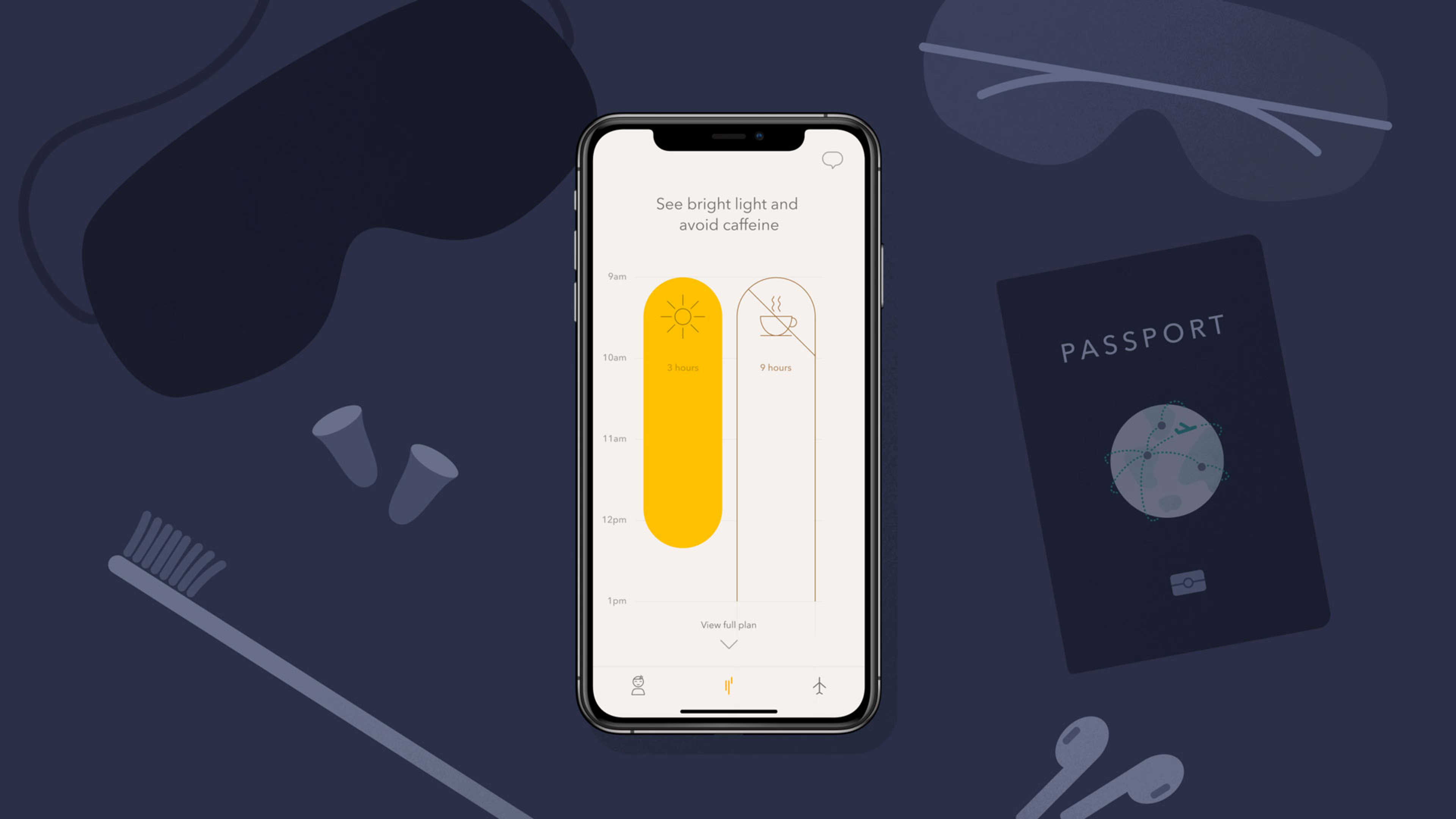Here’s one way to solicit unwanted attention in an airport: wear sunglasses at night.
In terms of attracting puzzled traveler looks, donning evening shades is right up there with in-flight sheet-masks and unwrapping tuna sandwiches. You hope people might assume you’re a celebrity trying to be incognito? But mostly they’re thinking, that person thinks they’re a celebrity.
In truth, I was only following directions. Timeshifter, the personalized jet lag app tested on NASA astronauts, commanded I avoid as much light as possible prior to boarding. That’s no easy feat in a Shanghai airport flooded with fluorescent light and flashing switchboards. It would have been better had I been completely blindfolded or the airport lights dimmed, but that’s simply unreasonable–that is, until the travel industry adjusts to better accommodate “timeshifters.”
“Our plans have a practicality filter, where the advice fits with what you can really achieve in the real world,” says Dr. Steve Lockley, a neuroscientist and associate professor of medicine at Harvard Medical School. The renowned expert in circadian rhythms and former NASA consultant developed the Timeshifter app algorithm after a decade of devising custom jet lag plans for Formula 1 drivers and astronauts.
“So if you’re asked to avoid light, it doesn’t mean being in complete darkness or closing your eyes. It means being exposed to less light than [usual],” explains Lockley. “There’s no point in advising you go to bed at 7:00 PM because the chances are you’re not really gonna do that.”
A personalized approach
The Timeshifter is a remarkably easy-to-use, straightforward app: Users simply enter in their full flight details (including multi-leg flights, stopovers), chronotype (morning person or a night owl), along with their individual sleep patterns. The latter is composed of your preferred bedtime/wake-up times as well as any other favorite aids, like melatonin or coffee intake.
Timeshifter then instantly delivers a personalized sleep schedule. It’s a full plan accompanied by push notification alerts like “avoid caffeine for the next 6 hours,” “expose yourself to light starting in 30 minutes,” or “take melatonin.” One can start it three days in advance of one’s flight or up until a minute before take-off, though the plan changes depending on advance lead time. The service costs $10 per jet lag plan or $24.99 for an annual subscription.
The app is unique in that it’s entirely based on sleep neuroscience and focused on shifting one’s internal clock forward. As Timeshifter cofounder and CEO Mickey Beyer-Clausen explains, beating jet lag involves moving one’s circadian cycle to the new time zone as soon as (feasibly) possible. But it’s not one-size-fits-all. Based on the information provided by each user, Timeshifter could have hundreds of different versions of the same trip, depending on sleep patterns or even when they started using the app.
For this reason, “it’s not something you can learn to do,” says Beyer-Clausen, a Danish entrepreneur who launched the app in 2017. “You need to have a personalized plan each time you travel.”

“[The clock] is a result of human evolution–millions of years rotating around the sun every 24 hours. It’s not something that’s going to go away,” he tells me. Essentially, biology is slow to adapt to new circumstances. If you drive a car or you go on a boat, the circadian clock shift just happens naturally. But it’s much slower adapting to radically new time zones, and a jet plane takes you so quickly to new time zones that it disrupts the clock. Recent studies attest to speeding up the adaptation of the body clock (and thereby preventing jet lag) by perfectly timing the light/dark cycle.
“Light is so powerful that you need that as a foundation,” explains Beyer-Clausen. “If you time the lighting, then use melatonin on top of that, it can help you shift even faster. But you need to take it [the melatonin] at the right time. And people also get that wrong.”
While several other jet lag apps exist, such as Jet Lag Rooster, they do not base circadian rhythm on personalized details. Others, like Uplift, recommend timed acupressure to prevent jet lag.

Beyer-Clausen stresses there’s even more at stake for constant travelers. Jet lag strips travelers of precious time with family members upon their return, and potentially even affects their health. It has been shown to possess the same health risks that impact shift workers, such as an increase of diabetes, strokes, and certain cancers. Extremely tired travelers are also more prone to drowsy rental car driving–21% of fatal crashes involve a fatigued driver.
“The consequences are much more significant as it related performance and safety,” Beyer-Clausen. “There’s a cost to it both personally and for your company and for your health.”
A more circadian-friendly industry?
Timeshifter might be based on the most recent sleep science, but following its advice could prove challenging to some. At the Global Wellness Summit in Singapore in October, attendees were gifted a free membership, which made for lively comparisons–often of the same flights. Of the nearly two dozen people I spoke to, the majority of those who actually followed the regimen attested to its efficacy. But a quarter admitted it was too ambitious a plan. Some said the app instructed them to stay up for several hours in the middle of the night.
I myself gave up during a midnight flight in which I was asked to stay up for five hours. That’s pretty tough once the aircraft turns off the lights.
To that end, Timeshifter recommends strategies like looking at your phone or playing on a laptop to absorb blue light. Still, it’s a tall order for travelers used to popping an Ambien as the wheels roll up.

“There’s a learning curve, if you will,” says Breus, who is also an investor in Timeshifter. “Quite frankly, there are some people who will just think: This is too much of a hassle, I’m just going to have four cocktails and hope for the best.”
Timeshifter attempts to help people on the compliance front. The app has a live-chat customer service program in which users can readily get advice on their plan. (That, however, isn’t much when they’re already in-flight.)

The travel industry isn’t quite yet on board with Timeshifter’s goals. People take their cues from airlines, which are more concerned with purely putting passengers to bed sleep than preventing jet lag. Poorly-timed meal service and dimmed lights are just a few issues confusing passengers’ clocks. (There’s no real way to personalize the flight experience, often even in first class.)
“The focus needs to be to shift your circadian clock as quickly as possible to the new time zone because then you sleep naturally and you wake up naturally, alert and energized,” says Beyer-Clausen. “That’s the bottom line.”
However, several travel brands seem to be keen to adopt the circadian clock philosophy. Timeshifter partnered with Six Senses Resorts to offer guests free membership, with other hotel groups on the horizon. The startup also secured a collaboration with United and is in talks with a dozen other airlines looking to offer the app free of charge to frequent fliers.
A growing number of hospitality brands look to personalize and improve the travel experience and Timeshifter might just be the one to open up the floodgates to more circadian rhythm products. As Breus reasons, once airlines start offering Timeshifter to clientele, they’re going to have to address some new questions: How do they help passengers adhere to the plans? How can they then improve the passenger experience?
“Whoever does it first will be in the leader seat for sure,” predicts Breus.
More than anything, Timeshifter hopes to educate people about the importance of regulating the sleep-wake cycle and thereby ensure better sleep health. Although the startup has no plans to release a suite of sleep products–it will strictly focus on jet lag–it thinks it can teach people how to create a stable, consistent sleep schedule.
Beyer-Clausen is hopeful after witnessing sleep health awareness seep into the public conversation in the last few years. There are now countless tools, apps, monitoring devices, even cuddly “sleep robots” and sleep-optimized homes to help consumers establish better habits.
“It’s going all in the right direction,” says Beyer-Clausen, noting that people today know far more about sleep health than even five years ago. Still, he notes, people are fussy about their snooze and oftentimes Timeshifter acts a disciplinarian of sorts. “Sometimes people complain a bit, like why can’t I put my bedtime to [this certain time] and wake up five hours later? It’s because it’s not good for you,” he laughs. “We teach people.”
Recognize your brand’s excellence by applying to this year’s Brands That Matter Awards before the early-rate deadline, May 3.
